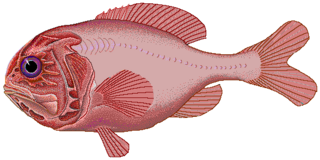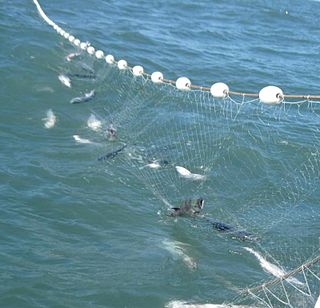Related Research Articles
The carrying capacity of an environment is the maximum population size of a biological species that can be sustained by that specific environment, given the food, habitat, water, and other resources available. The carrying capacity is defined as the environment's maximal load, which in population ecology corresponds to the population equilibrium, when the number of deaths in a population equals the number of births. The effect of carrying capacity on population dynamics is modelled with a logistic function. Carrying capacity is applied to the maximum population an environment can support in ecology, agriculture and fisheries. The term carrying capacity has been applied to a few different processes in the past before finally being applied to population limits in the 1950s. The notion of carrying capacity for humans is covered by the notion of sustainable population.
In population ecology and economics, maximum sustainable yield (MSY) is theoretically, the largest yield that can be taken from a species' stock over an indefinite period. Fundamental to the notion of sustainable harvest, the concept of MSY aims to maintain the population size at the point of maximum growth rate by harvesting the individuals that would normally be added to the population, allowing the population to continue to be productive indefinitely. Under the assumption of logistic growth, resource limitation does not constrain individuals' reproductive rates when populations are small, but because there are few individuals, the overall yield is small. At intermediate population densities, also represented by half the carrying capacity, individuals are able to breed to their maximum rate. At this point, called the maximum sustainable yield, there is a surplus of individuals that can be harvested because growth of the population is at its maximum point due to the large number of reproducing individuals. Above this point, density dependent factors increasingly limit breeding until the population reaches carrying capacity. At this point, there are no surplus individuals to be harvested and yield drops to zero. The maximum sustainable yield is usually higher than the optimum sustainable yield and maximum economic yield.
Bioeconomics is closely related to the early development of theories in fisheries economics, initially in the mid-1950s by Canadian economists Scott Gordon and Anthony Scott (1955). Their ideas used recent achievements in biological fisheries modelling, primarily the works by Schaefer in 1954 and 1957 on establishing a formal relationship between fishing activities and biological growth through mathematical modelling confirmed by empirical studies, and also relates itself to ecology and the environment and resource protection.

Overfishing is the removal of a species of fish from a body of water at a rate that the species cannot replenish, resulting in those species becoming underpopulated in that area. Overfishing can occur in water bodies of any sizes, such as ponds, rivers, lakes or oceans, and can result in resource depletion, reduced biological growth rates and low biomass levels. Sustained overfishing can lead to critical depensation, where the fish population is no longer able to sustain itself. Some forms of overfishing, such as the overfishing of sharks, has led to the upset of entire marine ecosystems. Types of overfishing include: Growth overfishing, recruitment overfishing, ecosystem overfishing.

A conventional idea of a sustainable fishery is that it is one that is harvested at a sustainable rate, where the fish population does not decline over time because of fishing practices. Sustainability in fisheries combines theoretical disciplines, such as the population dynamics of fisheries, with practical strategies, such as avoiding overfishing through techniques such as individual fishing quotas, curtailing destructive and illegal fishing practices by lobbying for appropriate law and policy, setting up protected areas, restoring collapsed fisheries, incorporating all externalities involved in harvesting marine ecosystems into fishery economics, educating stakeholders and the wider public, and developing independent certification programs.
The goal of Fisheries management is to produce sustainable biological, social, and economic benefits from renewable aquatic resources. Fisheries are classified as renewable because the organisms of interest usually produce an annual biological surplus that with judicious management can be harvested without reducing future productivity. Fisheries management employs activities that protect fishery resources so sustainable exploitation is possible, drawing on fisheries science and possibly including the precautionary principle. Modern fisheries management is often referred to as a governmental system of appropriate management rules based on defined objectives and a mix of management means to implement the rules, which are put in place by a system of monitoring control and surveillance. A popular approach is the ecosystem approach to fisheries management. According to the Food and Agriculture Organization of the United Nations (FAO), there are "no clear and generally accepted definitions of fisheries management". However, the working definition used by the FAO and much cited elsewhere is:
The integrated process of information gathering, analysis, planning, consultation, decision-making, allocation of resources and formulation and implementation, with enforcement as necessary, of regulations or rules which govern fisheries activities in order to ensure the continued productivity of the resources and the accomplishment of other fisheries objectives.
In population ecology and economics, optimum sustainable yield is the level of effort (LOE) that maximizes the difference between total revenue and total cost. Or, where marginal revenue equals marginal cost. This level of effort maximizes the economic profit, or rent, of the resource being utilized. It usually corresponds to an effort level lower than that of maximum sustainable yield.

The orange roughy, also known as the red roughy, slimehead and deep sea perch, is a relatively large deep-sea fish belonging to the slimehead family (Trachichthyidae). The UK Marine Conservation Society has categorized orange roughy as "vulnerable to exploitation". It is found in 3 to 9 °C, deep waters of the Western Pacific Ocean, eastern Atlantic Ocean, Indo-Pacific, and in the eastern Pacific off Chile. The orange roughy is notable for its extraordinary lifespan, attaining over 200 years. It is important to commercial deep-trawl fisheries. The fish is a bright, brick-red color, fading to a yellowish-orange after death.

Population ecology is a sub-field of ecology that deals with the dynamics of species populations and how these populations interact with the environment, such as birth and death rates, and by immigration and emigration.

The sustainable yield of natural capital is the ecological yield that can be extracted without reducing the base of capital itself, i.e. the surplus required to maintain ecosystem services at the same or increasing level over time. The term only refers to resources that are renewable in nature as extracting non-renewable resources will always diminish the natural capital. The sustainable yield of a given resource will generally vary over time with the needs of the ecosystem to maintain itself, e.g. a forest that has recently suffered a blight or flooding or fire will require more of its own ecological yield to sustain and re-establish a mature forest. While doing so, the sustainable yield may be much less. The term sustainable yield is most commonly used in forestry, fisheries, and groundwater applications.
In population dynamics, depensation is the effect on a population whereby, due to certain causes, a decrease in the breeding population leads to reduced production and survival of eggs or offspring. The causes may include predation levels rising per offspring and the Allee effect, particularly the reduced likelihood of finding a mate.
In forestry, the optimal rotation age is the growth period required to derive maximum value from a stand of timber. The calculation of this period is specific to each stand and to the economic and sustainability goals of the harvester.
A population model is a type of mathematical model that is applied to the study of population dynamics.

A fishery is an area with an associated fish or aquatic population which is harvested for its commercial or recreational value. Fisheries can be wild or farmed. Population dynamics describes the ways in which a given population grows and shrinks over time, as controlled by birth, death, and migration. It is the basis for understanding changing fishery patterns and issues such as habitat destruction, predation and optimal harvesting rates. The population dynamics of fisheries is used by fisheries scientists to determine sustainable yields.
This is a glossary of terms used in fisheries, fisheries management and fisheries science.
Fish mortality is a parameter used in fisheries population dynamics to account for the loss of fish in a fish stock through death. The mortality can be divided into two types:

Stock assessments provide fisheries managers with the information that is used in the regulation of a fish stock. Biological and fisheries data are collected in a stock assessment.

Ray Hilborn is a marine biologist and fisheries scientist, known for his work on conservation and natural resource management in the context of fisheries. He is currently professor of aquatic and fishery science at the University of Washington. He focuses on conservation, natural resource management, fisheries stock assessment and risk analysis, and advises several international fisheries commissions and agencies.

Overexploitation, also called overharvesting, refers to harvesting a renewable resource to the point of diminishing returns. Continued overexploitation can lead to the destruction of the resource. The term applies to natural resources such as: wild medicinal plants, grazing pastures, game animals, fish stocks, forests, and water aquifers.
The Gordon-Schaefer model is a bioeconomic model applied in the fishing industry. It may be used to compute the maximum sustainable yield. It takes account of biological growth rates, carrying capacity, and total and marginal costs and revenues.
References
- ↑ Quinn, Terrance J. (2008). "Ruminations on the development and future of population dynamics models in fisheries". Natural Resource Modeling. 16 (4): 341–392. doi:10.1111/j.1939-7445.2003.tb00119.x.
- ↑ Tsikliras, Athanassios C.; Froese, Rainer (2019). "Maximum Sustainable Yield". Encyclopedia of Ecology (Second ed.). Elsevier. pp. 108–115. doi:10.1016/B978-0-12-409548-9.10601-3. ISBN 9780444641304. S2CID 150025979.
- ↑ Finley, Carmel (2009). "The Social Construction of Fishing, 1949". Ecology and Society. 14: 6. doi:10.5751/ES-02704-140106.
- The Sunken Billions: The Economic Justification for Fisheries Reform World Bank Publications, Washington DC, 2009, ISBN 978-0-8213-7790-1
- Hart, Paul J B and Reynolds, John D (2002) Handbook of Fish Biology and Fisheries, Chapter 8, The economics of fisheries. Blackwell Publishing. ISBN 0-632-06482-X
- Glossary of Environment Statistics, Studies in Methods Series F, No. 67, United Nations, New York, 1997.
- FAO: Fisheries glossary
- NOAA: Fisheries glossary

